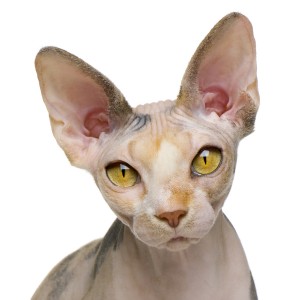Perhaps the world’s most bizarre feline, the Sphynx cat has a unique hairless look that sets it apart from other cats. But that’s not all. It’s a rather rare and unusual breed of cat, and has been described to feel like a warm suede hot water bottle. These cats need special care, but all the extra time and effort you dedicate to taking care of this cat will be well worth it. Their loving, playful and inquisitive nature makes them a wonderful cat to have around and call your own.
Breed History
Although it gets its name from the ancient Great Sphinx of Giza, Sphynx cats are a relatively new breed. There have been a number of occurrences of these hairless cats being born throughout history. But the Sphnyx cat first came to be well-recognized in the year 1966 in Canada when a domestic cat in Toronto gave birth to a hairless kitten. This was considered to be the result of a natural genetic mutation. From there, cats with the mutation were bred to give rise to the Sphynx breed. In 1970 the line became extinct due to the belief that the mutation caused health issues and breathing difficulties in the cats. But this did not spell the end to this breed. Before long, in 1975, a cat in Minnesota, named Jezebel, gave birth to a hairless kitten. The kitten was sold to a local breeder who revived the Sphynx breed by expanding and strengthening the gene pool. After many years of careful breeding, now Sphynx cats are a varied and genetically sound breed, though still rare. In 2002, the Cat Fancier’s Association accepted the cat breed for competition in the Championship Class.
Physical Characteristics
The most obvious feature of the Sphynx cat is its lack of hair. Although they are known as the “hairless” cats, they actually have warm peach fuzz fur on their bodies, especially on their nose, toes and tail. They may or may not have whiskers and eyebrows. They have long, lean bodies and a rounded abdomen. They possess characteristically large triangular ears, large paw pads and their tail is long and slender. The skin of a Sphynx cat is wrinkled, and they come in a variety of colors and patterns, including Siamese point patterns. An adult Sphynx cat normally weighs around 8 to 15 pounds, and male cats can be up to 25% bigger than their female counterparts.
Personality & Temperament
Sphynx cats are an inquisitive breed that likes to be the center of attention and love being handled and cuddled. They are intelligent cats that are agile, playful and sweet-tempered. They have a sense of adventure and mischief that make them fun to be around. They love human companionship, and will follow humans around the house. Sphynx cats are not for people who want a quiet, docile cat. They fit in well in homes with children, dogs or other cats. Oh, and these extroverts like to show off with their acrobatic tricks as well. So it’s probably a good thing that these cheeky felines are kept indoors for the most part.
Common Medical Problems
Sphynx cats have few health or genetic problems, and have a normal lifespan. They are generally considered to be a very robust breed. But they do still face some problems unique to their physical nature, most of which have to do with their hairlessness. During their 1st few weeks of life, Sphynx kittens are susceptible to respiratory infections. Sphynx cat breeders usually don’t allow kittens to move to new homes until they are at least 12 weeks old so they’re ready to handle a new environment. These hairless cats are also prone to sunburn and skin cancer, so it’s important that their sun exposure is limited. They are also susceptible to the cold, so care needs to be taken to keep this indoor cat nice and warm.
Sphynx cats also have sensitive digestive systems, particularly in that they are small. They can develop severe diarrhea after using medication or being fed diets that contain less than 80% protein. They can also acquire common feline illnesses, and are immunized just as other cat breeds are.
Hereditary myopathy (spasticity) and hypertrophic cardiomyopathy (HCM) are two genetic conditions that are found in this breed, with the latter being more common. HCM refers to a thickening of the left ventricle of the heart, and may not cause outward symptoms. Sphynx breeders are trying to eliminate this condition from the breed by scanning yearly and removing positive cats from their breeding program.
Special Care & Maintenance
Because they lack the protection of a fur coat, a hairless Sphynx cat requires special care. It’s recommended that you give them a weekly bath to remove the buildup of oil and dust on their skin. Their hair follicles give off oil, but unlike other cats, they have no hair to absorb the oil, and so their skin can easily become greasy. Because they have sensitive skin that burns easily, a very hot bath should be avoided. A sphynx cat’s eyes and ears should also be cleaned weekly to remove any eye discharge or earwax. As they lack hair around their ears, it’s easy for dirt to enter.
Sphynx cats are vulnerable to the sun and cold, and are meant to be indoor cats. So exposure to the outdoors should be limited. They may be taken outside on occasion if they are heavily supervised and the weather is right for them. Generally, the temperature inside your house should be kept around 70 to 80 degrees fahrenheit. Consider the Sphynx cat to be “naked” – if you would be cold naked, chances are that your cat is going to be too. You may need to clothe them during the winter. 
Also, as their bodies are constantly working to keep themselves warm, their metabolism is higher than other cats so they need to be fed more food at meal times. Always place dry food out for your cat and add one or two servings of wet food each day. They need to be fed high quality food with a good balance of fat and protein.
So if you think the intelligent and companionable Sphynx cat is for you, then you can purchase them from Sphynx cat breeders. Expect to pay more for a hairless Sphynx cat than you would for another cat breed. Sphynx cat adoption is also available, and costs less than buying a newborn kitten.

Please contribute to this article discussion and post a comment below...
Powered by Facebook Comments